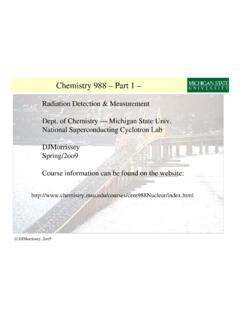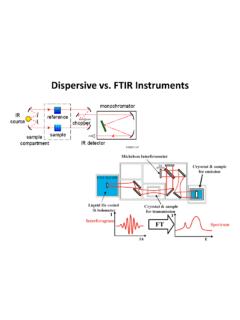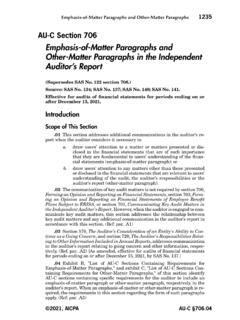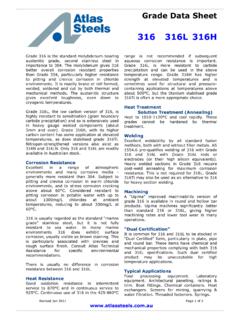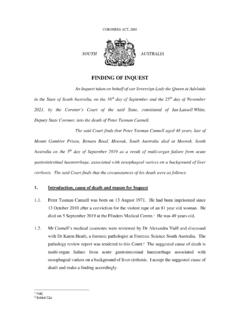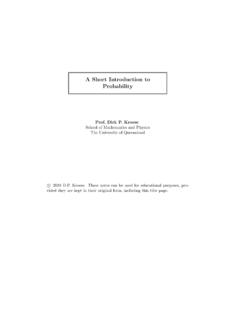Transcription of Chapter 9: Atomic Absorption Spectrometry
1 Chapter 9: Atomic Absorption SpectrometryChapter 9: Atomic Absorption SpectrometryRead: pp. 230 249 Problems: 9-1,3,5,6,8 Figure 9-13aA( )= ( )bC = log Po/PFlameFlame--BurnerBurnerIn AAS, the flame functions as (i) sample holder, (ii) desolvation source, and (iii) volatilization 9-5 Flame StructureFlame StructurePrimary zone: C2, CH, and other radical emissionSecondary zone: oxygen present so stable molecular oxides are formed for some metalsInterzonal regions: hot region, most widely used for analysisFigure 9-2h Optimum analysis position in the flame depends on the particular element and its chemistry.
2 Figure 9-4 Line Source Line Source Hollow Cathode LampHollow Cathode LampFigure 9-11 Cathode material made of the element of interest, Na HCL for the analysis of Na. An individual lamp is needed for each element. So AAS is a one-element-at-a-time measurement!Desired line of source is selected with monochromator:Figure 9-10 MonochromatorMonochromator Wavelength SeparatorWavelength SeparatorFigure 7-21n = d(sin i + sin r)R = / = nNN = grooves/mmProperties: light gathering power, stray light rejection,resolution, and linear dispersionOptical DetectorsOptical DetectorsSingle vs.
3 Multichannel detectors!S = kP + kdFigure 7-31bPhotomultiplier tubePhotomultiplier tubeSingleSingle--Beam Spectrometer:Beam Spectrometer:Figure 9-13aDoubleDouble--Beam Spectrometer:Beam Spectrometer:Figure 9-13bTypical Figures of Merit for AAST ypical Figures of Merit for AAS Detection limits: ng/mL (ppb) for flamepg/mL (ppt) for electrothermal Linear range: 103 104for flame102for electrothermal Precision: 1 2% RSD for flame5 10% RSD for electrothermal Accuracy: 1 2% for flame % for flame Remember: mg/L = ppm ug/L = ppb ng/L = ppt Chemical ProblemChemical ProblemTypical data for the determination of lead (Pb2+) by graphite furnace AAS in standards was g/mL ( AU), g/mL ( AU), g/mL ( AU) and in a sample of canned orange juice was AU.
4 Assume that these absorbance data were obtained for 2 L aliquots of standards and sample. Calculate the concentration of lead in the orange juice sample. Figure 9-7 Calibration Curve for PbCalibration Curve for Pb2+2+y = + = ( g/mL)ABSORBANCEC alibration equation: A = C + juice sample: A = + = = =2 and Chemical InterferencesSpectral and Chemical InterferencesRemember: Goal is neutral atoms in the gas phase!Remember: Goal is neutral atoms in the gas phase! Absorption or emission of an interfering species overlaps or lies so close to the analyte Absorption or emission that resolution is not possible.
5 Rare with HCLs. Presence of combustion products that exhibit broadband Absorption or particulates that scatter radiation. Both diminishpower of transmitted beam and lead to positive errors. If caused by fuel/oxidant mixture, then correction is possible by running a blank and performing background troublesome problem when Absorption or scattering results from the sample matrix. Interference by anions that form low volatility complexes with the analyte, and thus reduce the atoms formed. Lead to negative errors. Can be corrected by Releasing agents (cations added to preferentially react) Protecting agents ( , EDTA added to protect analyte cation) Dissociation equilibriaMO M + OM(OH)2 M + 2 OH Ionization equilibriaM M++ e In both cases, analyte atoms are not all in the proper form to absorb or emit at desired wavelength.
6 Lead to negative to Know!!! ablation chemical interference matrix aerosol detection limit nebulization Atomic Absorption Doppler effect releasing agent Atomic emission graphite furnace self- Absorption Atomic fluorescence hollow cathode lamp spectral
7 Interference atomization ionization interference ionization suppressor background correction Boltzman distribution

